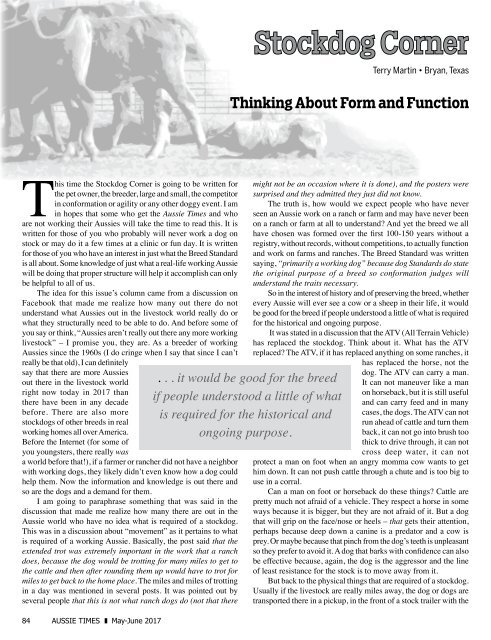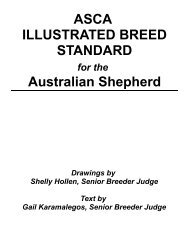You also want an ePaper? Increase the reach of your titles
YUMPU automatically turns print PDFs into web optimized ePapers that Google loves.
Stockdog Corner<br />
Terry Martin • Bryan, Texas<br />
Thinking About Form and Function<br />
This time the Stockdog Corner is going to be written for<br />
the pet owner, the breeder, large and small, the competitor<br />
in conformation or agility or any other doggy event. I am<br />
in hopes that some who get the Aussie Times and who<br />
are not working their Aussies will take the time to read this. It is<br />
written for those of you who probably will never work a dog on<br />
stock or may do it a few times at a clinic or fun day. It is written<br />
for those of you who have an interest in just what the Breed Standard<br />
is all about. Some knowledge of just what a real-life working Aussie<br />
will be doing that proper structure will help it accomplish can only<br />
be helpful to all of us.<br />
The idea for this issue’s column came from a discussion on<br />
Facebook that made me realize how many out there do not<br />
understand what Aussies out in the livestock world really do or<br />
what they structurally need to be able to do. And before some of<br />
you say or think, “Aussies aren’t really out there any more working<br />
livestock” – I promise you, they are. As a breeder of working<br />
Aussies since the 1960s (I do cringe when I say that since I can’t<br />
really be that old), I can definitely<br />
say that there are more Aussies<br />
out there in the livestock world<br />
right now today in <strong>2017</strong> than<br />
there have been in any decade<br />
before. There are also more<br />
stockdogs of other breeds in real<br />
working homes all over America.<br />
Before the Internet (for some of<br />
you youngsters, there really was<br />
a world before that!), if a farmer or rancher did not have a neighbor<br />
with working dogs, they likely didn’t even know how a dog could<br />
help them. Now the information and knowledge is out there and<br />
so are the dogs and a demand for them.<br />
I am going to paraphrase something that was said in the<br />
discussion that made me realize how many there are out in the<br />
Aussie world who have no idea what is required of a stockdog.<br />
This was in a discussion about “movement” as it pertains to what<br />
is required of a working Aussie. Basically, the post said that the<br />
extended trot was extremely important in the work that a ranch<br />
does, because the dog would be trotting for many miles to get to<br />
the cattle and then after rounding them up would have to trot for<br />
miles to get back to the home place. The miles and miles of trotting<br />
in a day was mentioned in several posts. It was pointed out by<br />
several people that this is not what ranch dogs do (not that there<br />
84 AUSSIE TIMES May-June <strong>2017</strong><br />
. . . it would be good for the breed<br />
if people understood a little of what<br />
is required for the historical and<br />
ongoing purpose.<br />
might not be an occasion where it is done), and the posters were<br />
surprised and they admitted they just did not know.<br />
The truth is, how would we expect people who have never<br />
seen an Aussie work on a ranch or farm and may have never been<br />
on a ranch or farm at all to understand? And yet the breed we all<br />
have chosen was formed over the first 100-150 years without a<br />
registry, without records, without competitions, to actually function<br />
and work on farms and ranches. The Breed Standard was written<br />
saying, “primarily a working dog” because dog Standards do state<br />
the original purpose of a breed so conformation judges will<br />
understand the traits necessary.<br />
So in the interest of history and of preserving the breed, whether<br />
every Aussie will ever see a cow or a sheep in their life, it would<br />
be good for the breed if people understood a little of what is required<br />
for the historical and ongoing purpose.<br />
It was stated in a discussion that the ATV (All Terrain Vehicle)<br />
has replaced the stockdog. Think about it. What has the ATV<br />
replaced? The ATV, if it has replaced anything on some ranches, it<br />
has replaced the horse, not the<br />
dog. The ATV can carry a man.<br />
It can not maneuver like a man<br />
on horseback, but it is still useful<br />
and can carry feed and in many<br />
cases, the dogs. The ATV can not<br />
run ahead of cattle and turn them<br />
back, it can not go into brush too<br />
thick to drive through, it can not<br />
cross deep water, it can not<br />
protect a man on foot when an angry momma cow wants to get<br />
him down. It can not push cattle through a chute and is too big to<br />
use in a corral.<br />
Can a man on foot or horseback do these things? Cattle are<br />
pretty much not afraid of a vehicle. They respect a horse in some<br />
ways because it is bigger, but they are not afraid of it. But a dog<br />
that will grip on the face/nose or heels – that gets their attention,<br />
perhaps because deep down a canine is a predator and a cow is<br />
prey. Or maybe because that pinch from the dog’s teeth is unpleasant<br />
so they prefer to avoid it. A dog that barks with confidence can also<br />
be effective because, again, the dog is the aggressor and the line<br />
of least resistance for the stock is to move away from it.<br />
But back to the physical things that are required of a stockdog.<br />
Usually if the livestock are really miles away, the dog or dogs are<br />
transported there in a pickup, in the front of a stock trailer with the



